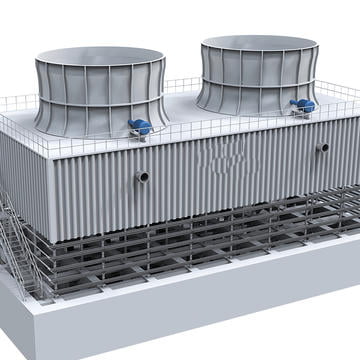Introduction
Pultruded FRP Cooling Towers is an advanced cooling system constructed using pultruded fiberglass-reinforced plastic (FRP) structural components. The pultrusion process involves pulling continuous strands of glass fibers through a resin bath and then shaping them through a heated die, resulting in high-strength, lightweight, and corrosion-resistant structural profiles. Unlike traditional cooling towers made of wood, concrete, or steel, pultruded FRP cooling towers are designed to withstand harsh environmental conditions, including exposure to chemicals, high humidity, extreme temperatures, and UV radiation. Their lightweight construction, combined with high mechanical strength, makes them easy to install, transport, and maintain while ensuring long-lasting performance. These cooling towers are particularly beneficial for industrial applications where chemical resistance, durability, and minimal maintenance are essential.
Advantages of Pultruded FRP Cooling Tower
Superior Corrosion Resistance
One of the most significant advantages of pultruded FRP cooling towers is their exceptional resistance to corrosion. Traditional cooling towers made of metal structures are susceptible to rust and corrosion when exposed to moisture, chemicals, and industrial fumes. On the other hand, pultruded FRP cooling towers are inherently non-corrosive, making them ideal for industries dealing with acidic, alkaline, or chemically reactive environments.
High Strength-to-Weight Ratio
Pultruded FRP components offer exceptional mechanical strength while being significantly lighter than steel or concrete. This high strength-to-weight ratio makes the structure easy to transport, lift, and install, reducing installation labor and time. Despite being lightweight, FRP profiles maintain structural integrity under heavy loads, making them capable of withstanding high wind speeds, mechanical stress, and seismic forces. This is particularly beneficial for cooling towers installed in areas prone to strong winds, earthquakes, or heavy industrial loads.
Long-Term Durability
The inherent durability of pultruded FRP materials makes these cooling towers last significantly longer than their metal or wooden counterparts. Unlike wood, which rots, warps, or absorbs moisture, and steel, which rusts and deteriorates, FRP remains stable and unaffected by environmental elements. Due to their high resistance to weathering, moisture, UV radiation, and chemical exposure, pultruded FRP cooling towers maintain their performance and structural integrity for decades with minimal degradation.
Low Maintenance Requirements
Since pultruded FRP cooling towers do not corrode, rot, or require regular painting, they have significantly lower maintenance needs compared to traditional cooling tower materials. Unlike steel structures that require frequent rust treatment, welding repairs, and recoating, FRP towers need only periodic inspections and basic cleaning to maintain optimal performance. This reduction in maintenance time and costs ensures higher operational efficiency and lower overall lifecycle expenses, making them an excellent investment for industrial cooling applications.
UV and Weather Resistance
Cooling towers are often exposed to direct sunlight, extreme temperatures, high humidity, and heavy rainfall, which can degrade traditional materials over time. Pultruded FRP is designed to withstand prolonged UV exposure without fading, cracking, or losing structural integrity. Additionally, FRP materials are highly resistant to temperature fluctuations, meaning they do not become brittle in extreme cold or soften under intense heat. This makes them ideal for outdoor installations in diverse climatic conditions, from tropical environments to freezing industrial sites.
Fire Retardant Properties
Many pultruded FRP materials are manufactured with fire-retardant resins, making them highly resistant to fire hazards. Unlike traditional wooden cooling towers, which pose a significant fire risk, FRP structures have self-extinguishing properties and low smoke generation, making them safer for industrial use. This is especially crucial for power plants, petrochemical industries, and HVAC systems, where fire safety regulations are stringent and non-compliance can result in severe consequences.
Easy Installation and Customization
Pultruded FRP cooling towers are modular in design, allowing for easy transportation, assembly, and on-site modifications. The lightweight nature of FRP reduces the need for heavy lifting equipment, while the pre-fabricated profiles simplify installation, cutting down labor costs and project timelines. Additionally, FRP cooling towers can be custom-designed to meet specific industrial requirements, including various sizes, load capacities, and airflow configurations. This level of customization ensures optimal cooling performance based on specific industrial needs.
Eco-Friendly and Sustainable
Pultruded FRP cooling towers are an environmentally friendly alternative to steel and wood structures. Since FRP does not require chemical treatments, protective coatings, or excessive water consumption for maintenance, it helps reduce the ecological footprint of industrial cooling operations.
Conclusion
Pultruded FRP Cooling Towers are a revolutionary advancement in industrial cooling technology, offering an ideal balance of strength, corrosion resistance, durability, and cost efficiency. Their ability to withstand harsh chemicals, extreme weather, and mechanical stress makes them a preferred choice over traditional cooling towers made of wood, steel, or concrete. By choosing pultruded FRP cooling towers, industries can reduce maintenance costs, extend the lifespan of their cooling systems, and improve overall efficiency. With continuous advancements in composite materials and pultrusion technology, these cooling towers are expected to play a key role in future industrial cooling applications, providing reliable and sustainable solutions across multiple industries.

